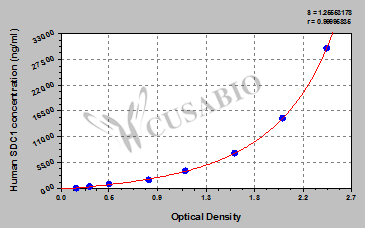Syndecan-1 (SDC1) is a transmembrane heparan sulfate proteoglycan that plays important roles in cell adhesion, migration, and signaling processes. As a member of the syndecan family, it functions as a co-receptor for various growth factors and cytokines, helping their interaction with primary receptors and modulating downstream signaling pathways. SDC1 is particularly important in tissue development, wound healing, and cancer progression. Its expression levels can influence tumor growth, metastasis, and angiogenesis. The protein serves as a biomarker in multiple disease contexts and is widely studied in oncology and regenerative medicine research.
The Human Syndecan-1/CD138(SDC1) ELISA Kit (CSB-E14983h) is designed for quantitative measurement of SDC1 in human samples. This sandwich ELISA accommodates serum, plasma, and tissue homogenates with a detection range of 4.7 ng/mL to 300 ng/mL and sensitivity of 1.17 ng/mL. The assay requires 50-100 μL sample volume and can be completed within 1-5 hours. Detection is performed at 450 nm wavelength. This provides researchers with a reliable tool for SDC1 quantification in Homo sapiens specimens.
Application Examples
Note: The following application examples are drawn from a selection of publications citing this product. For additional applications, please refer to the full list of references in the "Citations" section.
This ELISA kit has been used in research examining endothelial glycocalyx integrity and vascular endothelial function. Studies have used syndecan-1 as a biomarker to measure endothelial damage and glycocalyx degradation in various pathological conditions.
• Endothelial glycocalyx research: Measuring glycocalyx integrity using syndecan-1 as an established biomarker of endothelial surface layer damage
• Vascular endothelial function studies: Evaluating endothelial cell injury and dysfunction through measurement of soluble syndecan-1 levels
• Biomarker correlation analysis: Examining syndecan-1 in conjunction with other endothelial injury markers to characterize vascular pathology
• Microvascular endothelial cell research: Analyzing syndecan-1 levels in isolated intestinal microvascular endothelial cells and associated tissue samples






